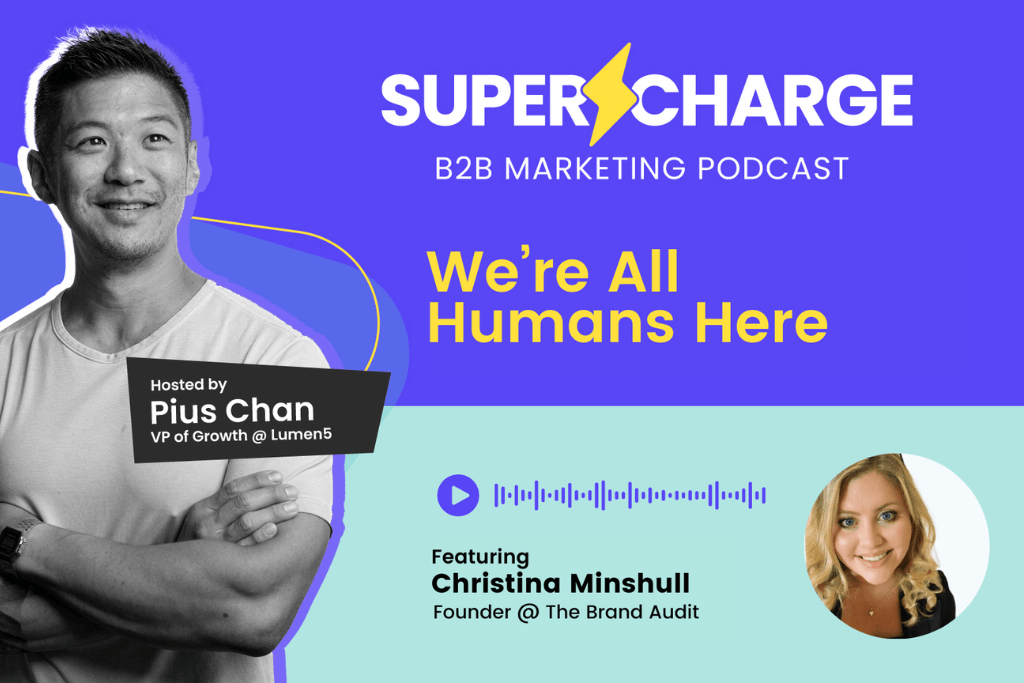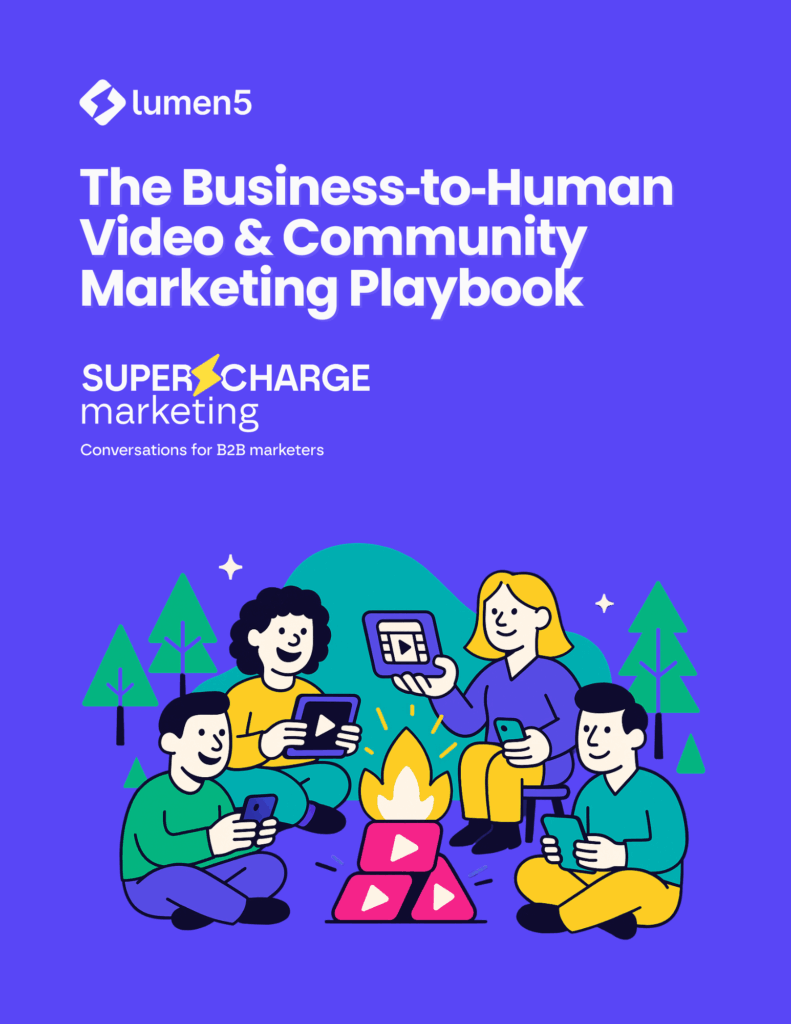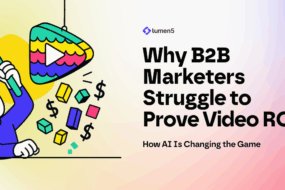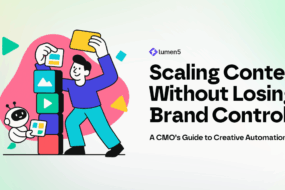
When Christina Minshull talks about B2B marketing, she doesn’t sound like your average strategist. She doesn’t open with funnel charts or click-through rates. She starts with people.
“At the end of the day, you’re selling to that end individual,” Christina told us on the Supercharge Marketing podcast. “Whether they’re buying a cloud solution or a can of Coca-Cola, there are emotions involved. Their wants, their needs, even their fears — that’s what you need to understand.”
It’s a simple truth that many enterprise marketing teams overlook: brands don’t buy, humans do. Yet scroll through most B2B campaigns today and you’ll find the same formulaic messaging, stock imagery, and perfectly polished videos that sound more like corporate robots than humans having a conversation. Christina sees this as a dangerous blind spot. “We’ve seen brands really die off because they haven’t been listening to their customers,” she said. “They haven’t been adapting to their wants and needs in a meaningful way.”
This blog is about fixing that. It’s about moving from business-to-business thinking to Business-to-Human (B2H) storytelling — and reimagining video strategy to build real connection at scale.
In the following sections, we’ll unpack Christina’s most powerful insights on authenticity, listening before creating, and adapting to a new generation of decision-makers. You’ll learn how enterprise CMOs can turn executive thought leadership, customer wins, and even everyday conversations into video stories that actually resonate — not just rack up impressions.
And because we know strategic advice is only useful if you can see it in action, we’ve built a B2H Content Hub to go with this post. Inside, you’ll find:
- Exclusive podcast snippets from Christina’s conversation
- Real-world examples from brands like Notion, Airtable, and Slack
- A free B2H Video & Community Playbook to help your team start shifting today
Now let’s dive in: here’s why the future of enterprise marketing belongs to brands that dare to be human.
1️⃣ The Shift from B2B to B2H: Why Humans, Not Companies, Buy Your Product
Christina Minshull doesn’t mince words when it comes to the outdated “business-to-business” mindset.
“So many brands are still talking to logos,” she said on the podcast. “But logos don’t make decisions — people do. At the end of the day, you’re selling to that end individual, and you need to understand their wants, their needs, even their fears.”
It sounds obvious, yet most enterprise marketing campaigns still feel like they’re built for faceless corporations: jargon-heavy messaging, generic stock visuals, and overly safe, boardroom-approved content that appeals to no one in particular. The result? Decision-makers scroll past, untouched and unmoved.
This disconnect is more than just a creative misstep — it’s a business risk. According to LinkedIn’s B2B Institute, 95% of B2B buyers say feeling a personal connection to a brand significantly influences their decision to consider or purchase. And yet, research shows the majority of enterprise content fails to spark that connection because it focuses on product features, not human stories or emotions.
Christina sees this mistake play out constantly across industries:
“We’ve seen a lot of brands really die off because they haven’t been listening to their customers,” she said. “They haven’t been adapting to their wants and needs in a meaningful way.”
So what does B2H look like in practice?
It’s the difference between:
- Sending a cold product update email vs sharing a customer’s 60-second video on how it solved their late-night workflow bottleneck.
- Polishing a 5-minute corporate overview reel vs capturing a candid moment of your VP of Product sketching on a whiteboard, talking about a real-world client challenge.
Buyers remember brands that see them as people. And in an enterprise setting where every major purchase involves consensus-building among multiple stakeholders, emotional resonance travels faster and sticks longer than feature checklists.
📍 Want to see how leading SaaS brands are applying B2H thinking in their video strategies? We’ve curated three real-world examples inside the B2H Content Hub — including Christina’s full breakdown of campaigns that got it right (and why).
The shift is happening. Brands that cling to old B2B tactics will keep shouting into the void. Brands that dare to speak human, show real faces, and share authentic experiences will win mindshare — and market share — every time.
2️⃣ Authenticity Over Perfection: The New Standard for Enterprise Video
Christina Minshull has a front-row seat to how B2B brands are still clinging to outdated video norms — and she’s not impressed.
“The polished corporate videos are a thing of the past for B2B businesses,” she told us on the podcast. “People don’t want to watch something that feels like an ad. They want something that feels real, human, unscripted.”
For decades, enterprise video strategy has been shaped by TV-era thinking: big budgets, scripted storyboards, perfect lighting, and months of production cycles. The assumption was that a flawless final product equals professionalism and trustworthiness.
But modern buyers, especially millennials and Gen Z now stepping into decision-making roles, have been raised on YouTube, TikTok, and live video. They’re fluent in “real.” And they can spot a hyper-polished corporate promo in the first five seconds — then swipe right past it.
Research backs Christina’s point. According to Wyzowl’s 2025 State of Video Marketing Report, 76% of B2B buyers say they prefer video content that feels conversational and authentic over scripted sales pitches. Brands embracing this reality are seeing remarkable results.
Take Slack’s “So Yeah, We Tried Slack” launch video. It was scrappy, humorous, and rooted in real workplace frustrations — not a glossy, jargon-filled pitch. It exploded because it felt like a genuine story about real humans at work, not another ad.
Or look at Airtable’s short customer clip series, often shot on smartphones or Zoom. They sacrificed cinematic perfection to capture raw enthusiasm from users explaining how Airtable saved them time. Engagement outperformed their high-budget ad campaigns by double digits.
Christina believes authenticity is a non-negotiable competitive edge now:
“What works really well is tapping into those emotions, tapping into those wants, those needs — even those fears — and speaking to that end individual directly,” she said.
For CMOs, this isn’t about throwing production quality out the window. It’s about prioritizing speed, relatability, and emotional connection over glossy finishes that add cost and delay without adding value. Quick-turn clips of your CEO sharing a thought on LinkedIn, or a candid customer success story filmed on-site, can often outperform six-figure agency productions because they feel real.
📍 Want to see side-by-side examples of raw vs polished B2B videos (and why the raw version wins)? Christina shares her analysis — plus brand case studies from Notion, Airtable, and Slack — in the B2H Content Hub.
The lesson: your buyers aren’t craving perfection. They’re craving truth. Show them something human, and they’ll give you something rare in enterprise marketing today: their attention.
3️⃣ Listening Before Filming: Unlocking Untapped Audience Insights
Christina Minshull says one of the biggest problems with B2B video today has nothing to do with creativity, budgets, or tools. The real issue? Brands aren’t listening.
“We’ve seen a lot of brands really die off because they haven’t been listening to their customers,” Christina said during our conversation. “They haven’t been adapting to their wants and needs in a meaningful way.”
Enterprise teams often pour time and money into video campaigns built on assumptions. They map buyer personas once a year, rely on dated insights from sales teams, and launch videos based on internal priorities rather than external signals. The result? A polished campaign no one asked for, solving a problem no one truly cares about.
Listening changes everything. Christina describes it as “putting on the headphones instead of grabbing the megaphone.” Before you hit record, you should already know:
- What your audience is frustrated about right now.
- The specific challenges or opportunities keeping them awake at night.
- The tone, language, and formats they engage with organically.
That’s not guesswork. Today’s enterprise marketers have access to a constant stream of real-time data points:
- Social listening tools surface what prospects talk about on LinkedIn, X, and industry forums.
- Customer success teams hear firsthand where workflows break down — turn those stories into content.
- Community feedback from user groups or Slack channels shows what topics spark the most discussion.
A global fintech brand recently reoriented its video strategy using this approach. Before launching its latest explainer series, the team analyzed 1,200 LinkedIn comments from target buyers over three weeks. They scrapped their initial script about “efficiency at scale” and produced a set of candid, 60-second clips addressing real complaints about onboarding complexity. The campaign drove a 4x higher click-through rate compared to their last video push.
Christina sees this as a mindset shift CMOs need to lead:
“Brands are too focused on talking about themselves. If you stop and listen first — really listen — your customers will hand you your content strategy on a silver platter.”
Enterprise buyers are telling you exactly what they want to watch. It’s just buried in comments, community threads, and sales calls. The marketers who mine those insights before they press record will consistently produce video that resonates, engages, and converts.
When in doubt, don’t create more noise. Start by hearing what the market is already saying — and make them feel heard.
4️⃣ Generational Buyers and Visual Velocity: Why Speed + Format Matter More Than Ever
Christina Minshull has a warning for CMOs trying to market to today’s enterprise decision-makers: you can’t rely on yesterday’s formats or timelines anymore.
“We’re seeing more and more millennials in leadership roles,” Christina told us on the podcast. “Even some Gen Zs are coming into leadership positions. They’re not going to read a 500-page whitepaper. They like to consume content differently.”
This generational shift has huge implications for how B2B brands create and distribute video content:
- Short-form, scroll-friendly video is table stakes. According to Demand Gen Report, 70% of millennial B2B buyers say they prefer video content under two minutes long when researching vendors.
- Real-time relevance beats slow perfection. A report from Content Marketing Institute found that enterprise marketers who publish video within 24–48 hours of recording see 2–3x higher engagement than those with long production cycles.
- Mobile-first is no longer optional. Gen Z leaders often research vendors between meetings on their phones. If your content isn’t optimized for vertical, quick consumption, it gets skipped.
Christina calls this concept “visual velocity.”
“Because your competitors are moving so fast, you can’t spend months on a single video anymore,” she explained. “You need to adopt what I call the Ryan Reynolds approach — fast advertising. Create high-quality content that’s on brand, but get it out there while your audience is still talking about the topic.”
This doesn’t mean sacrificing brand integrity or putting out sloppy videos. It means structuring your team and tools to capture ideas quickly, produce fast-turn edits, and publish while the conversation is still hot.
Example: A global cybersecurity firm recently used Lumen5 to repurpose a 45-minute webinar into seven short LinkedIn clips within 36 hours. Their sales team reported that prospects were referencing those clips in calls the same week, leading to higher meeting acceptance rates and faster deal velocity. That kind of impact doesn’t happen when marketing takes three weeks to post a recap.
The takeaway? Your future buyers are used to real-time content, human tone, and snackable formats. If you want to stay in their consideration set, you need to meet them where they are — and at their speed.
Because in this new buying era, speed isn’t just an advantage. It’s survival.
5️⃣ Your B2H Video Playbook: Building a Human-Centered Content Engine
By now, one truth should be clear: video strategy isn’t about formats or tech — it’s about people. But how do you operationalize “human-first” thinking inside a large enterprise where layers of approval, tight bandwidth, and brand governance often slow everything down?
Christina Minshull says it starts with shifting mindset and workflow.
“Marketers are spending too much time talking about their brand and not enough time talking to their audience,” she told us. “If you build your video strategy around the human on the other side of the screen, you’ll never run out of compelling stories to tell.”
📍 We’ve turned Christina’s insights into a free “B2H Video & Community Playbook” — complete with templates, checklists, and real-world examples from leading SaaS brands. Download it now in the B2H Content Hub to see exactly how to bring this strategy to life inside your organization.
The CMOs, VPs, and marketing directors who make this shift now won’t just outpace their competitors in content volume. They’ll earn something far more valuable in an era of noisy feeds and shrinking attention: authentic connection with the humans who choose their brand.
The Future of Enterprise Marketing Belongs to the Humans Who Dare
The brands that listen and adapt to humans will outlast the ones that keep shouting into the void.
That’s the shift staring enterprise marketing leaders in the face right now. The days of polished corporate monologues are numbered. The buyers you need to reach — from first-time managers to seasoned execs — expect you to show up with empathy, speed, and authenticity. They want to hear real voices, not brand scripts. They want to feel your story, not just read about your features.
For CMOs, this is both a challenge and an invitation.
It’s a challenge because it asks you to dismantle some of the processes you’ve built over decades: long approval chains, polished videos that take months, KPIs that count views instead of value. It’s an invitation because it opens a new, more human way of doing enterprise marketing — one that builds emotional resonance, trust, and influence faster than any ad spend ever could.
You already have everything you need to start: the listening tools, the leaders willing to show up on camera, the customer stories sitting in your CRM. All that’s missing is a playbook to help you scale the right way.
We built that playbook with Christina’s insights in mind. Inside the B2H Content Hub, you’ll find her full podcast conversation, real-world examples from brands who are getting this right, and a free toolkit to help you transform your enterprise video strategy over the next quarter.
The choice ahead is simple: keep doing what feels safe and polished — or lead the shift to B2H and meet your buyers where they truly are. As Christina says, “If you stop talking at people and start listening to them, they’ll hand you your strategy.”






